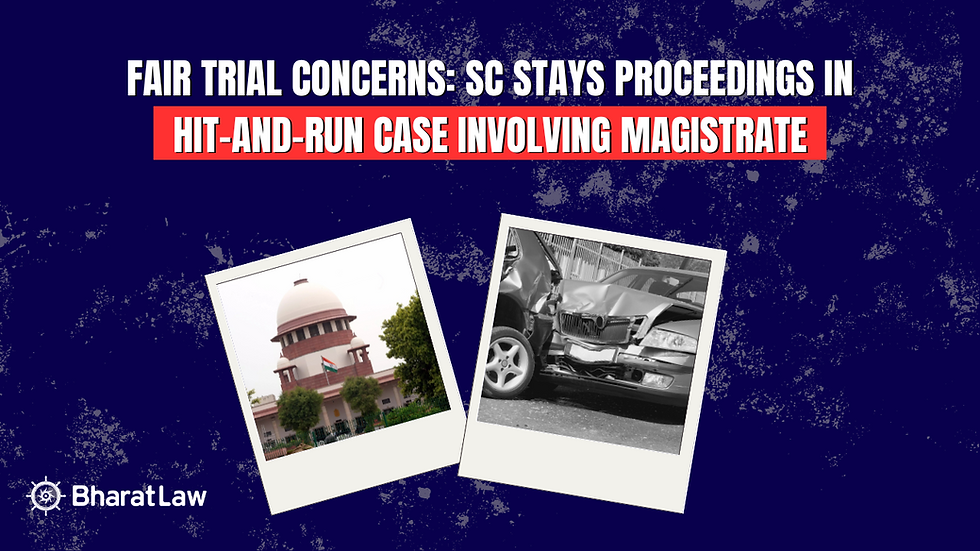Recognizing Sacrifice: The Selfless Service of Armed Forces Personnel Deserves Respect, Not Needless Litigation
- Chintan Shah

- Dec 4, 2024
- 3 min read
Summary of the Judgment
Case Name: Union of India & Ors. vs. Saroj Devi
Date of Judgment: 3rd December 2024
Bench: Hon'ble Justice Abhay S. Oka and Hon'ble Justice Augustine George Masih
Advocates: Shri Vikramjeet Banerjee (Additional Solicitor General) for the appellants, Shri K. Parameshwar (Senior Advocate) for the respondent
Cited Judgments:
Kanchan Dua v. Union of India & Anr. [(2020) 18 SCC 709]
Radhika Devi v. Union of India & Ors. [(2020) 18 SCC 715]
Background and Factual Matrix
This case revolves around the denial of a Liberalised Family Pension (LFP) to Saroj Devi, the widow of Naik Inderjeet Singh, a soldier in the Indian Army who succumbed to cardiopulmonary arrest while on duty in Jammu & Kashmir. Despite the extreme climatic conditions under which the soldier died, the authorities reclassified the death from a "battle casualty" to a "physical casualty," denying the respondent LFP. The Armed Forces Tribunal, however, ruled in her favour, directing the authorities to grant her the LFP along with an ex-gratia payment. This appeal by the Union of India challenges the Tribunal's decision.
Key Issues
Whether the death of Naik Inderjeet Singh fell under the category of a "battle casualty" as per Army Order 1 of 2003.
Whether the death meets the conditions specified under Clause (f) of Category E for granting LFP.
Contentions by the Parties
For the Appellants: Shri Vikramjeet Banerjee argued that the death, caused by cardiopulmonary arrest, was a "physical casualty" attributable to military service but did not qualify as a "battle casualty." Citing precedents (Kanchan Dua and Radhika Devi), he contended that the Tribunal's findings were erroneous and unsupported by the facts.
For the Respondent: Shri K. Parameshwar maintained that the death occurred in extreme climatic conditions during Operation Rakshak, a recognised military operation near the Line of Control (LoC). He emphasised that Army Order 1 of 2003 categorically includes deaths caused by illnesses in such operational contexts under "battle casualties."
Judicial Analysis
The Supreme Court, in its judgment authored by Hon'ble Justice Abhay S. Oka, undertook a meticulous examination of the factual and legal aspects of the case.
Classification of Death: The Court observed that the deceased was actively participating in an Area Domination Patrol near the LoC under severe climatic conditions. His duties under Operation Rakshak, combined with the hazardous environment, justified the initial classification of his death as a "battle casualty." Quoting the relevant clause from Army Order 1 of 2003, the Court noted:
“Casualties occurring while operating on the International Border or Line of Control due to natural calamities and illness caused by climatic conditions are classified as 'battle casualties'.”
Applicability of Clause (f), Category E: The Court further held that the death arose from a "war-like situation," as described in Category E. The inclusive definition of such situations extends beyond sub-clauses (i) to (iii) to cover operational hazards encountered during patrolling near the LoC.
Precedents Distinguished: The judgments in Kanchan Dua and Radhika Devi were distinguished on factual grounds. The former involved a death in non-operational circumstances, and the latter did not involve extreme climatic conditions.
Judicial Caution and Empathy: The Court admonished the appellants for their unsympathetic approach, stating:
“In a case like this, the respondent ought not to have been dragged to this Court. Decision-making authorities must exhibit greater sensitivity towards the families of deceased soldiers who sacrifice their lives in the line of duty.”
Outcome
The Supreme Court upheld the Tribunal's ruling, directing the appellants to grant LFP to the respondent. Additionally, costs of ₹50,000 were imposed on the appellants for their failure to exhibit sensitivity.
Key Takeaways
Legal Interpretation of "Battle Casualty": This judgment underscores the importance of recognising operational hazards, including those caused by extreme climatic conditions, under the ambit of "battle casualties." It reiterates that deaths resulting from such circumstances are not merely physical casualties but deserve the status of "battle casualties."
Judicial Empathy Towards Soldiers' Families: The Court's decision highlights the need for a compassionate approach in dealing with claims by military families. It sets a precedent for treating cases involving the deaths of armed forces personnel with greater fairness and understanding.
Clarification on Precedents: By distinguishing earlier judgments, the Court emphasised the context-specific nature of legal interpretation in cases involving military service.
Conclusion
This landmark judgment reaffirms the judiciary's role as a protector of the rights of armed forces personnel and their families. It also serves as a reminder to authorities to adopt a balanced and humane approach when evaluating such claims. The decision sets a significant precedent in recognising the sacrifices of soldiers and ensuring their families are not denied rightful benefits.
As Hon'ble Justice Oka aptly observed in closing:
“The selfless service and sacrifices of armed forces personnel deserve recognition and respect, not needless litigation.”
This judgment is a step towards safeguarding the dignity and welfare of soldiers and their families in India.



Comments